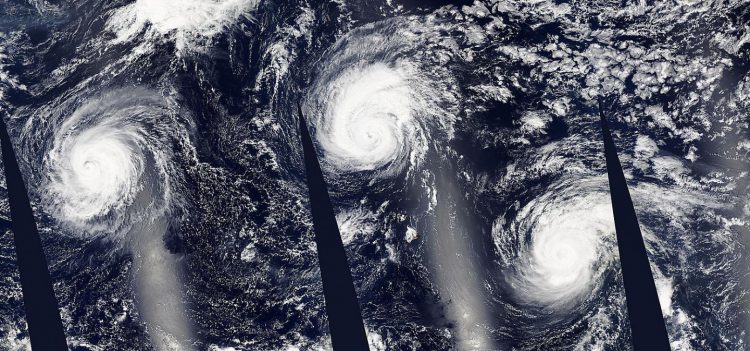NASA's Aqua Satellite sees Typhoon Kilo headed west

The MODIS instrument aboard NASA's Aqua satellite made several passes over the Pacific Ocean on Sept. 3 and captured Typhoon Kilo (left) and Hurricanes Ignacio (center) and Jimena (right) across the Pacific Ocean. Credits: NASA Goddard MODIS Rapid Response Team
NASA's Aqua satellite passed over Kilo and the Moderate Resolution Imaging Spectroradiometer or MODIS instrument took an image of the storm that showed Kilo maintained an eye and thick bands of thunderstorms wrapping into the low-level center.
Kilo also appeared more symmetric in the MODIS image.
At 11 a.m. EDT (5 a.m. HST/1500 UTC) the center of Typhoon Kilo was located near latitude 24.0 north and longitude 166.0 west. That's 702 nautical miles east-northeast of Wake Island.
The Joint Typhoon Warning Center noted Kilo was moving toward the southwest near 1 knot (1 mph/2 kph). Maximum sustained winds are near 80 knots (92 mph/148 kph).
JTWC expects Kilo to re-intensify over the next several days and peak at 120 knots by September 6 over the open waters of the Northwestern Pacific Ocean.
Media Contact
All latest news from the category: Earth Sciences
Earth Sciences (also referred to as Geosciences), which deals with basic issues surrounding our planet, plays a vital role in the area of energy and raw materials supply.
Earth Sciences comprises subjects such as geology, geography, geological informatics, paleontology, mineralogy, petrography, crystallography, geophysics, geodesy, glaciology, cartography, photogrammetry, meteorology and seismology, early-warning systems, earthquake research and polar research.
Newest articles

Making diamonds at ambient pressure
Scientists develop novel liquid metal alloy system to synthesize diamond under moderate conditions. Did you know that 99% of synthetic diamonds are currently produced using high-pressure and high-temperature (HPHT) methods?[2]…

Eruption of mega-magnetic star lights up nearby galaxy
Thanks to ESA satellites, an international team including UNIGE researchers has detected a giant eruption coming from a magnetar, an extremely magnetic neutron star. While ESA’s satellite INTEGRAL was observing…

Solving the riddle of the sphingolipids in coronary artery disease
Weill Cornell Medicine investigators have uncovered a way to unleash in blood vessels the protective effects of a type of fat-related molecule known as a sphingolipid, suggesting a promising new…





















